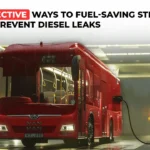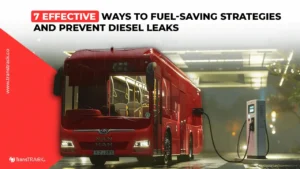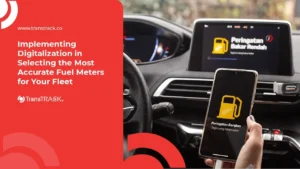Learn How Crumple Zone Help You in a Crash!
Posted on July 22, 2024 by Nur Wachda Mihmidati

When a vehicle is involved in a crash, one of the key safety features working behind the scenes is the crumple zone. The concept of a crumple zone is designed to protect occupants by absorbing and distributing energy from the impact. With structures specifically designed to crush and bend, crumple zones reduce the crash forces received by the cabin, providing additional protection for passengers and improving overall safety. In this TransTRACK article, we will explore how crumple zones function, why this design is important, and how modern safety technology innovations complement this feature to improve safety on the road.
What is a crumple zone?
The crumple zone is a part of the vehicle designed to absorb and distribute energy during a crash. This area is usually located at the front and rear of the vehicle.
Crumple zones are one of the important innovations in modern vehicle safety, significantly reducing the risk of injury to passengers during an accident.
What is the main function of a crumple zone?
The main function of a crumple zone is to absorb and distribute energy during a collision, thereby reducing the direct impact on passengers and improving safety. Here are more details on its functions:
Reduces Impact Energy
The crumple zone is designed to crush and bend during a crash, which diverts and absorbs the kinetic energy of the impact, thereby reducing the force received by the passenger cabin.
Slows the Rate of Deceleration
By gradually absorbing crash energy, the crumple zone slows down the vehicle’s deceleration rate more gently, reducing the shock felt by passengers.
Protects Cabin Structure
By diverting crash energy to areas designed to disintegrate, crumple zones help keep cabin structures intact and safe for passengers.
Reduced Risk of Injury
By reducing the forces received by the cabin and passengers, crumple zones significantly reduce the risk of serious and fatal injuries in a crash.
Overall, crumple zones are an important component of vehicle design that aims to improve passenger safety and reduce the impact of a crash.
How does a crumple zone help in a crash?
Crumple zones help in crashes in the following ways:
Absorb Kinetic Energy
During a crash, the crumple zone is designed to absorb kinetic energy from the impact. Parts made of specialized materials, such as metals, are designed to crumble, crush and bend to reduce the energy received by the vehicle cabin.
Diverting Energy from the Cabin
By crushing and bending the crumple zone area, crash energy is diverted away from the passenger cabin. This prevents the energy from directly affecting the interior of the vehicle where the passengers are.
Reduces the Rate of Deceleration
The crumple zone helps to gradually slow down the vehicle. By gradually reducing the force of the crash, the crumple zone reduces the shock received by the occupants and vehicle structure, making the impact of the crash softer.
Preserves Cabin Structure
By absorbing and diverting crash energy to areas designed to be destroyed, the crumple zone helps keep parts of the cabin intact. This reduces the likelihood of direct damage to the passenger space and improves safety.
Works with Other Safety Systems
Crumple zones work in conjunction with other safety features, such as seat belts and airbags. The energy absorbed by the crumple zone allows seat belts and airbags to work more effectively in protecting occupants.
In these ways, crumple zones contribute significantly to reducing the risk of serious injury in a crash, improving the overall safety of the vehicle.
What is the difference between a crumple zone and an airbag?
Crumple zones and airbags are two vehicle safety features designed to protect occupants in a crash, but they have different functions and mechanisms:
Crumple Zone
- Function: A crumple zone is an area on a vehicle designed to absorb and distribute energy from a crash. Its function is to crush and bend upon impact, thereby reducing the force received by the passenger cabin.
- Location: Crumple zones are usually located at the front and rear of the vehicle, in the areas most likely to experience a collision.
- Mechanism of Action: Crumple zones work by crushing and bending special materials to absorb crash energy gradually. This helps reduce the vehicle’s deceleration rate and diverts energy away from the passenger cabin.
- Permanent: The crumple zone structure is a permanent part of the vehicle design and cannot be easily repaired or replaced after an accident.
Airbag
- Function: An airbag is an air bag that is activated in the event of a collision to protect passengers from direct impact with the inside of the vehicle such as the steering wheel, dashboard, and windows. Its function is to provide additional cushioning and reduce the risk of injury to the passenger’s body.
- Location: Airbags are placed in several areas of the vehicle, including the steering wheel (steering airbag), dashboard (front passenger airbag), and seats (side airbags).
- Working Mechanism: Airbags are activated by crash sensors that detect the force of the impact. When a collision is detected, the airbag quickly inflates and provides cushioning that protects the occupants from direct impact with the hard parts of the vehicle.
- Meanwhile: Airbags are components that are only activated in the event of an accident and will then need to be replaced or repaired after their use.
Comparison
- Crumple zones absorb and divert crash energy by crushing vehicle parts, while airbags provide direct protection by cushioning the crash.
- Crumple zones work at the structural level of the vehicle and cannot be changed after an accident, while airbags are electronic systems designed to be activated and then replaced after use.
- Both work in tandem to improve occupant safety, with crumple zones reducing crash energy and airbags providing additional occupant protection.
Crumple zones have proven to be an important element in vehicle design to protect occupants from the impact of a crash. By absorbing and distributing crash energy, crumple zones help reduce the risk of injury and improve safety on every journey.
However, safety and efficiency must also be considered in vehicle fleet management. This is where TransTRACK can provide the best solution for you. We offer an advanced fleet management system, designed to improve the safety and operational efficiency of your fleet. With features such as real-time monitoring, location tracking, and vehicle performance analysis, TransTRACK helps you manage your fleet more effectively and safely.
Improve the safety and efficiency of your fleet with cutting-edge solutions from TransTRACK. Contact us today to learn more about our fleet management system and how we can help you!
Topic :
Recommended Articles

 Bahasa Indonesia
Bahasa Indonesia








